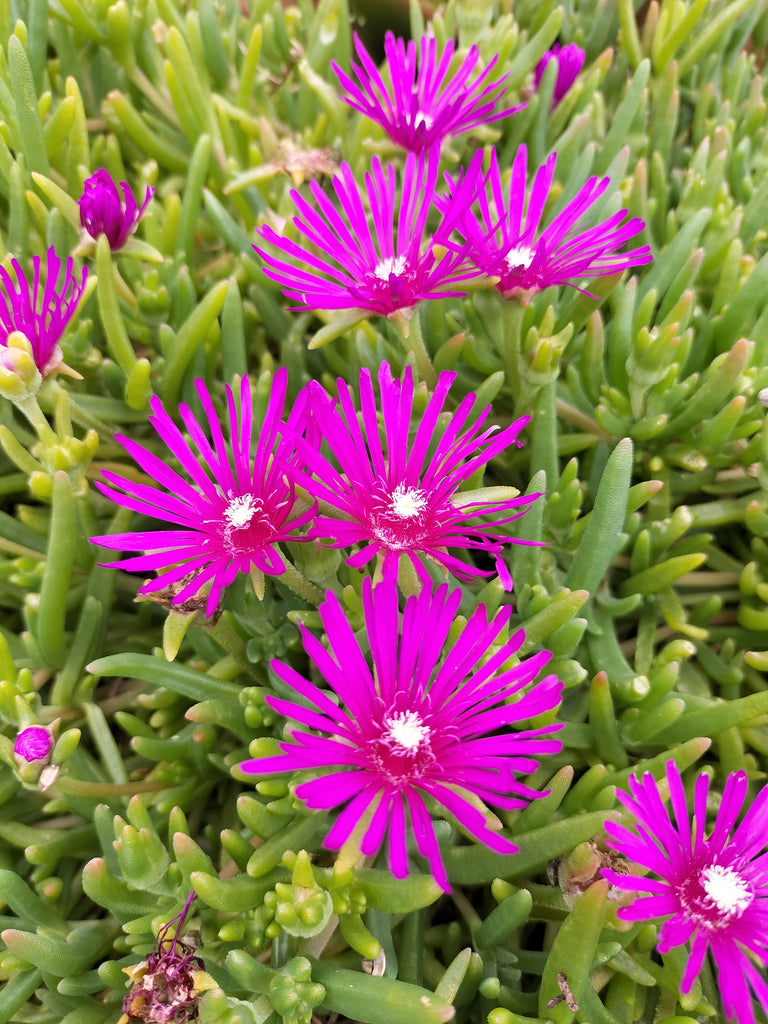Delosperma cooperi, commonly known as the Hardy Ice Plant or Pink Carpet, is a stunning succulent that has captured the hearts of gardeners worldwide. Its vibrant, daisy-like flowers and low-maintenance nature make it an ideal choice for various landscaping applications. In this comprehensive guide, we will delve into the fascinating world of Delosperma cooperi, exploring its characteristics, cultivation techniques, and numerous benefits.

Delosperma cooperi is a perennial succulent native to South Africa. It is characterized by its low-growing, mat-forming habit, typically reaching heights of 4 to 6 inches. The plant’s succulent leaves are fleshy and cylindrical, storing water to help it withstand drought conditions. The most striking feature of Delosperma cooperi is its abundant, long-lasting flowers. These vibrant blooms range in color from deep pink to magenta and often cover the plant entirely, creating a breathtaking carpet of color.
Delosperma cooperi is a relatively easy-to-grow plant that thrives in well-draining soil and full sun. It is highly tolerant of drought and heat, making it a perfect choice for xeriscaping and low-water gardens. While it can tolerate some shade, it will produce the most abundant blooms when planted in full sun.
When planting Delosperma cooperi, it is essential to choose a well-draining soil mix. A combination of equal parts potting soil, sand, and perlite provides excellent drainage and aeration. Avoid planting in heavy clay soil, as this can lead to root rot.
Delosperma cooperi is drought-tolerant and does not require frequent watering. In fact, overwatering can be detrimental to the plant’s health. Allow the soil to dry out completely between waterings, and reduce watering frequency during the winter months.
Delosperma cooperi thrives in full sun. It requires at least 6 hours of direct sunlight per day to produce abundant blooms. However, it can tolerate some partial shade, especially in hot, arid climates.
Delosperma cooperi is remarkably tolerant of extreme temperatures, including both heat and cold. It can withstand freezing temperatures and high summer heat. It is also adaptable to various humidity levels, making it suitable for a wide range of climates.
Delosperma cooperi is a low-maintenance plant that does not require frequent fertilization. However, you can apply a balanced, slow-release fertilizer in the spring to promote healthy growth and flowering.
Pruning is not typically necessary for Delosperma cooperi. However, you can trim back any leggy or overgrown stems to maintain a tidy appearance.
Delosperma cooperi can be easily propagated through stem cuttings or leaf cuttings. To propagate by stem cuttings, simply cut a healthy stem and remove the lower leaves. Plant the cutting in well-draining soil and keep it moist until it roots. Leaf cuttings can be propagated by placing the leaves on top of well-draining soil and lightly covering them. Keep the soil slightly moist until the leaves root.
Delosperma cooperi is relatively resistant to pests and diseases. However, it can be susceptible to mealybugs and scale insects, especially in dry conditions. These pests can be controlled by using insecticidal soap or neem oil. Additionally, overwatering can lead to root rot, so it is important to avoid overwatering.
Delosperma cooperi is a versatile plant with numerous landscaping applications. It can be used as a groundcover to create a colorful and low-maintenance carpet of flowers. It is also well-suited for rock gardens, where it can cascade over rocks and crevices. Additionally, Delosperma cooperi can be planted in containers and hanging baskets, adding a splash of color to patios and balconies.
In addition to its aesthetic appeal, Delosperma cooperi offers several practical benefits. It is a drought-tolerant plant that requires minimal water, making it an ideal choice for water-wise gardens. It is also low-maintenance, requiring minimal pruning and fertilization. Furthermore, Delosperma cooperi attracts pollinators such as bees and butterflies, contributing to a healthy ecosystem.
A: Yes, Delosperma cooperi is highly tolerant of frost and can withstand temperatures as low as -20°F (-29°C).
A: Delosperma cooperi is drought-tolerant and does not require frequent watering. Allow the soil to dry out completely between waterings.
A: Yes, Delosperma cooperi can be grown in pots. Choose a well-draining pot and use a cactus or succulent potting mix.
A: To encourage more blooms, ensure that your Delosperma cooperi receives plenty of sunlight. Additionally, you can apply a balanced, slow-release fertilizer in the spring.
Delosperma cooperi is a stunning and resilient succulent that adds a vibrant touch to any garden. Its low-maintenance nature, drought tolerance, and beautiful flowers make it a popular choice among gardeners. Whether you are a seasoned gardener or a beginner, Delosperma cooperi is a rewarding plant to cultivate. By following the cultivation tips provided in this guide, you can enjoy the beauty of this remarkable plant for years to come.